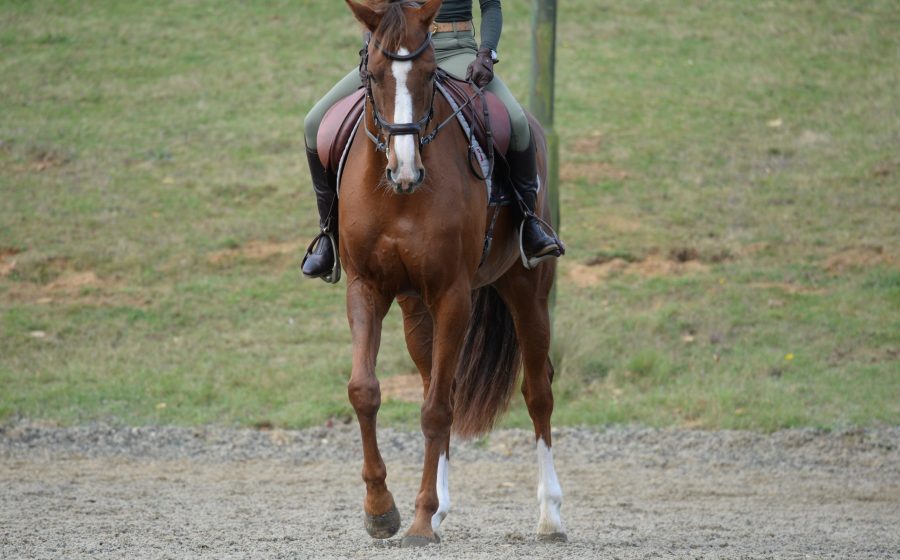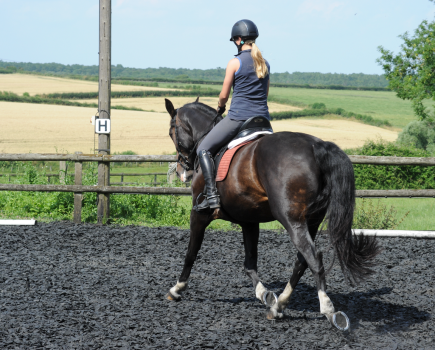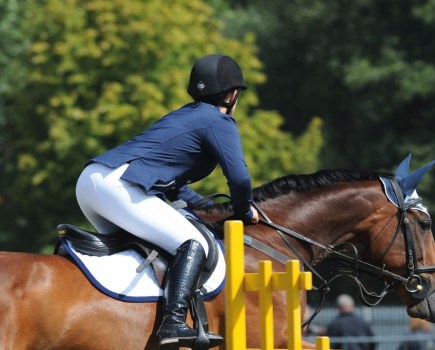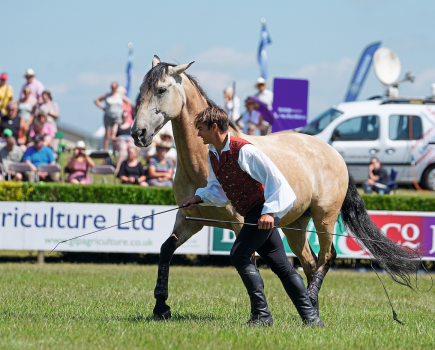Turn-on-the-forehand is a simple lateral movement that is very handy for all horses and riders to be able to do — and not just those who enjoy doing dressage. Turn-on-the-forehand will improve your horse’s suppleness and acceptance of the contact. It is a useful way to teach a horse to move off each leg, and it will make opening and closing gates out hacking a lot simpler too.
You may also sometimes hear this movement called turn ‘about’ the forehand. It’s the same thing. When a horse turns on the forehand, their hindquarters move in an arc around their front legs, which remain virtually still. The inside hindleg moves across in front of the outside hindleg. The other hooves will step up, straighten and put down again. A true turn-on-the-forehand will keep the rhythm and footfalls of the walk while it’s happening.
I ride and explain how to start working towards a turn-on-the-forehand in the following video:
How to ride turn on the forehand
To ride a turn-on-the-forehand, close the inside leg that you want them to move away from as you half-halt a little with the outside rein. It’s a balancing act between your inside leg and your outside rein, so it’s a great test of rider coordination. Only ask for a couple of steps to start with, so the horse doesn’t get anxious about it. You want them to keep thinking and moving forwards, and not take a backwards step into it. Always ride forwards out of a turn-on-the-forehand to finish.
You can use your voice in training and a couple of clicks is a good way of activating them without causing any tension that putting your leg on might cause. Think about keeping the walk relaxed and soft with a clear four beats.
Although it’s not an exercise we ride in a test, it’s a useful schooling exercise for young horses. The horse I’m riding in the video above is more experienced, but even more advanced horses benefit from doing turn-on-the-forehand because it reminds them to stay soft and keep moving away from the leg.
Turn on the forehand: the benefits
1 Introduces lateral work
Turn-on-the-forehand can be used as an introduction to lateral work — in particular, leg yield — as it teaches your horse the concept of yielding to leg pressure.
2 Improves the walk
It helps if your horse has a tendency to tense up and their walk becomes two-beat (the walk should be four-beat), because it makes them think about where their feet are. Turn-on-the-forehand also gives you more control of the rhythm of the walk and over each individual step.
3 Encourages acceptance of the contact
It improves your horse’s acceptance of the contact. You’re using both your legs and the reins and your horse learns to accept them.
4 Enhances a horse’s outline
It encourages your horse to become rounder in their outline. The flexion and asking them to step across with their hindlegs encourages the horse to let go and become softer over their back, too.
Turn on the forehand: the rider’s role
Balance and coordination of aids plays a big part in being able to ride a turn-on-the-forehand successfully. You ask for flexion with your inside hand and put a little more weight onto your inside seat bone. Watch you don’t collapse your inside shoulder, as this causes your weight to shift to the outside and is likely to unbalance your horse.
Your inside leg asks your horse to move away. Then you use the outside rein to balance that movement. Your outside leg controls how quickly your horse moves around.
Exercise 1: Check your horse is straight
This simple exercise checks how well you can coordinate your aids. It takes practise and may take a few repetitions for your horse to understand what you’re asking them to do.
How to ride it:
- Ride up the centre line in trot.
- Ask your horse to flex their neck to the left while keeping their body straight.
- After a few strides, straighten their neck and then ask for flexion to the right.
Exercise 2: Turn on the forehand
As you ride this movement, your horse’s back should remain straight. Only ask for a couple of steps to begin with, so your horse doesn’t get anxious. Once they’re happy, build up the number of steps.
How to ride it:
- On the left rein, riding off the track, ask for halt.
- Ask for a little flexion to the left.
- Use your left leg to ask the horse to move their hindquarters to the right.
- Half-halts on your outside rein prevent your horse from walking off.
- Throughout the movement, maintain a slight flexion at the poll to the inside.
- Once you’ve completed the movement, walk forwards in a straight line.
Exercise 3: Turn about the forehand
Next, you can play with the movement and, rather than halting, make an obvious half-halt before you start. You’ll turn about the forehand from walk.
How to ride it:
- In a walk, ride off the track a little.
- Shorten the stride until your horse almost halts.
- At this point, ask for slight flexion to the inside.
- Have your inside leg at the girth and your outside leg a little behind the girth.
- Use your inside leg to ask your horse to move their inside hindleg so that it steps under their body. They can now pivot around the inner front leg, which steps ever so slightly forwards, and move the quarters around their front end.
- Look up where you want to go.
- Your inside rein gently leads, balanced by your outside rein to avoid too much bend in the neck.
- Once you’ve completed the movement, ride your horse forwards in walk.








